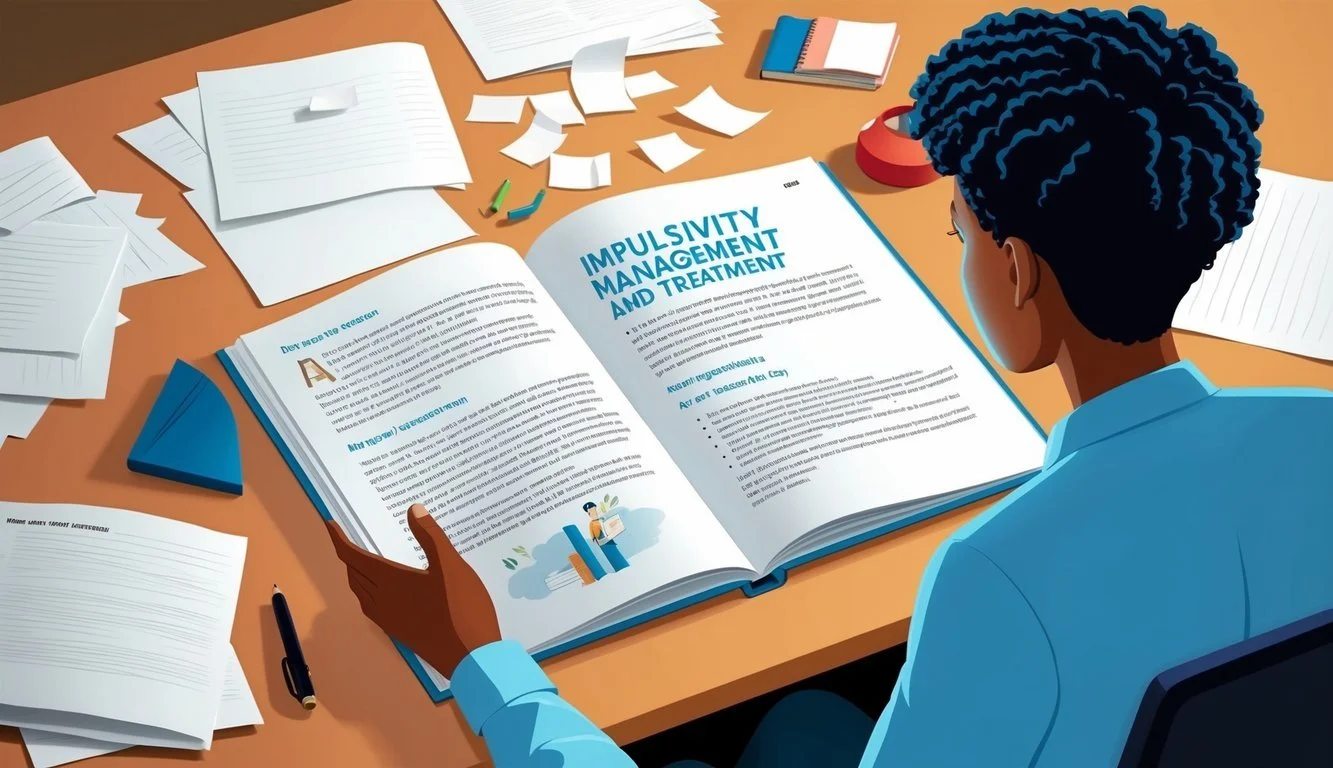Top Impulsivity Books: Master Self-Control and Transform Your Life
Impulsivity can significantly impact a person's life, relationships, and overall well-being. Books focused on impulse control offer valuable insights and practical strategies for those seeking to understand and manage impulsive behaviors. These works provide readers with a range of perspectives on impulsivity, covering psychological, social, and economic implications.
Several notable books on the topic have garnered attention for their comprehensive approaches. "Stop Me Because I Can't Stop Myself" delves into the challenges faced by individuals with impulse control disorders, offering a candid look at the daily struggles and potential consequences of unchecked impulsivity. Another recommended read, "Overcoming Impulse Control Problems," presents cognitive-behavioral therapy techniques proven effective in managing urges related to gambling, stealing, fire-setting, and overspending.
For those interested in a more academic exploration, "Impulsivity: How Time and Risk Influence Decision Making" examines the multifaceted nature of impulsive behavior. This volume from the Nebraska Series on Motivation explores concepts such as delayed gratification, risk assessment, and inhibition of inappropriate actions. These books collectively provide a solid foundation for understanding and addressing impulsivity in various contexts.
Understanding Impulsivity
Impulsivity involves acting without forethought or consideration of consequences. It shapes behavior across various domains and can significantly impact decision-making and life outcomes.
Definition and Scope
Impulsivity refers to the tendency to act hastily without adequate planning or reflection. It encompasses a range of behaviors characterized by quick, unplanned reactions to internal or external stimuli.
Impulsive actions often result in undesirable consequences due to their poorly conceived nature. The scope of impulsivity extends beyond mere spontaneity, influencing areas like financial decisions, substance use, and interpersonal relationships.
Psychologists categorize impulsivity into different types, including motor impulsivity (acting without thinking), cognitive impulsivity (making quick decisions), and non-planning impulsivity (lack of forethought).
The Neuroscience of Impulse Control
Neuroimaging studies have shed light on the brain regions involved in impulse control. The prefrontal cortex plays a crucial role in regulating impulsive behaviors.
This area is responsible for executive functions like planning, decision-making, and inhibition of inappropriate responses. Dysfunction in the prefrontal cortex has been linked to increased impulsivity.
The limbic system, particularly the amygdala, also influences impulsive behaviors. This region processes emotions and can override rational thought processes, leading to impulsive actions.
Neurotransmitters like dopamine and serotonin play significant roles in modulating impulsivity. Imbalances in these chemicals can affect an individual's ability to control impulses.
Psychological Theories of Impulsivity
Several psychological theories attempt to explain impulsivity. The dual-process theory suggests two systems in decision-making: a fast, intuitive system and a slower, more deliberative one.
Impulsivity may result from an overreliance on the fast system. Cognitive-behavioral theories propose that impulsive behaviors stem from maladaptive thought patterns and learned responses.
The reinforcement sensitivity theory links impulsivity to individual differences in sensitivity to reward and punishment. High sensitivity to rewards may lead to more impulsive behavior.
Personality theories, such as the Five-Factor Model, include impulsivity as a facet of broader traits like extraversion or neuroticism. These theories help explain individual variations in impulsive tendencies.
Impulsivity Across the Lifespan
Impulsivity manifests differently at various stages of life, influenced by biological, psychological, and social factors. Age-related changes in brain development and life experiences shape impulsive tendencies from childhood through older adulthood.
Childhood and Adolescent Impulsivity
Children and adolescents often exhibit higher levels of impulsivity compared to adults. This is largely due to ongoing brain development, particularly in the prefrontal cortex responsible for impulse control. Young children may struggle with delayed gratification and emotional regulation.
Adolescence brings a surge in impulsive behaviors, partly driven by hormonal changes and increased risk-taking tendencies. Peer influence plays a significant role during this stage, sometimes encouraging impulsive actions.
Impulsivity in youth can manifest as:
Interrupting others
Acting without thinking
Difficulty waiting turns
Engaging in risky behaviors
Adult Impulsivity
As individuals enter adulthood, impulsivity generally decreases. The prefrontal cortex reaches full maturity, enhancing decision-making skills and self-control. However, impulsive tendencies can persist in some adults, impacting various life domains.
Adult impulsivity may present as:
Impulse buying
Relationship conflicts due to hasty reactions
Substance abuse
Risky financial decisions
Stress, mental health conditions, and certain personality traits can contribute to impulsive behaviors in adulthood. Developing coping strategies and self-awareness becomes crucial for managing these tendencies.
Impulsivity in Older Age
Contrary to popular belief, impulsivity doesn't necessarily diminish with age. While some older adults may exhibit improved emotional regulation, others may experience increased impulsivity due to age-related changes in brain function.
Factors influencing impulsivity in older age include:
Cognitive decline
Medication side effects
Social isolation
Financial pressures
Impulsive behaviors in older adults might manifest as gambling, overspending, or making hasty health-related decisions. Recognizing these tendencies and seeking support can help maintain a balanced lifestyle in later years.
Measurement and Assessment
Assessing impulsivity involves various methodologies to capture its multifaceted nature. These approaches range from self-reported questionnaires to behavioral tasks and neurological examinations, each providing unique insights into impulsive tendencies.
Self-Report Inventories
Self-report measures are widely used to evaluate impulsivity. The Barratt Impulsiveness Scale (BIS-11) is a prominent 30-item questionnaire that assesses motor, attentional, and non-planning impulsiveness. Another popular tool is the UPPS-P Impulsive Behavior Scale, which measures five facets of impulsivity: negative urgency, lack of premeditation, lack of perseverance, sensation seeking, and positive urgency.
These inventories offer quick administration and broad applicability across various settings. Researchers and clinicians often prefer self-report measures for their ease of use and ability to capture subjective experiences of impulsivity.
Behavioral Assessments
Behavioral tasks provide objective measures of impulsive actions. The Go/No-Go task evaluates response inhibition by requiring participants to respond quickly to certain stimuli while withholding responses to others. The Iowa Gambling Task assesses decision-making impulsivity by simulating real-life decisions under uncertainty.
Other common behavioral assessments include:
Stop-Signal Task
Delay Discounting Task
Balloon Analogue Risk Task
These tasks offer valuable insights into specific aspects of impulsive behavior, complementing self-report measures.
Neurological Evaluations
Advanced neuroimaging techniques have revolutionized impulsivity assessment. Functional Magnetic Resonance Imaging (fMRI) allows researchers to observe brain activity during impulsive decision-making. These scans often reveal increased activation in the prefrontal cortex and limbic system in individuals with high impulsivity.
Electroencephalography (EEG) measures electrical activity in the brain, providing information about neural processes associated with impulsive behaviors. Event-related potentials (ERPs) derived from EEG data can indicate differences in cognitive processing between impulsive and non-impulsive individuals.
Neurological assessments offer a deeper understanding of the biological basis of impulsivity, though they are typically used in research settings rather than clinical practice due to their complexity and cost.
Impulsivity and Mental Health
Impulsivity intertwines with various mental health conditions, affecting decision-making and behavior. It manifests differently across disorders, presenting unique challenges for individuals and treatment approaches.
ADHD and Impulsivity
Attention-Deficit/Hyperactivity Disorder (ADHD) strongly correlates with impulsive behaviors. People with ADHD often act without thinking, interrupting others or making hasty decisions.
This impulsivity can lead to difficulties in school, work, and relationships. Children with ADHD may blurt out answers in class or struggle to wait their turn.
Adults might engage in risky behaviors like reckless driving or impulsive spending. Treatment typically involves a combination of medication and behavioral therapy to help manage impulsive tendencies and improve self-control.
Impulsivity in Mood Disorders
Bipolar disorder and depression can both feature impulsive behaviors, though they manifest differently. During manic episodes, individuals with bipolar disorder may exhibit increased impulsivity.
This can result in:
Excessive spending
Risky sexual behavior
Sudden career changes
In depressive states, impulsivity might appear as self-harm or suicide attempts. For those with depression, impulsive actions often stem from emotional distress or attempts to alleviate negative feelings.
Treatment focuses on mood stabilization and developing coping strategies to manage impulsive urges.
Substance Abuse and Impulsive Behaviors
Impulsivity plays a significant role in substance abuse disorders. It can contribute to initial drug experimentation and difficulty maintaining sobriety.
Individuals with high impulsivity may:
Struggle to resist cravings
Engage in drug-seeking behavior despite negative consequences
Make impulsive decisions that jeopardize recovery efforts
Substance abuse can also exacerbate impulsive tendencies, creating a cycle of impulsive behavior and drug use. Treatment approaches often include cognitive-behavioral therapy to address impulsive patterns and develop healthier decision-making skills.
Medication-assisted treatment may help reduce cravings and impulsive drug-seeking behaviors in some cases.
Management and Treatment
Effective approaches to managing and treating impulsivity involve a combination of behavioral interventions, medication, and psychotherapy. These strategies target different aspects of impulsive behavior and can be tailored to individual needs.
Behavioral Interventions
Cognitive-behavioral techniques form a cornerstone of impulsivity management. These methods focus on identifying triggers and developing coping strategies. Patients learn to recognize impulsive urges and practice alternative responses.
Mindfulness training has shown promise in reducing impulsive behaviors. It teaches individuals to observe their thoughts and feelings without immediately reacting to them.
Structured daily routines and environmental modifications can help minimize impulsive actions. This may include removing temptations and creating a supportive living environment.
Skills training in areas such as problem-solving and anger management equips individuals with tools to handle challenging situations more effectively.
Pharmacological Treatments
Stimulant medications, commonly used for ADHD, can help reduce impulsivity in some individuals. These drugs work by increasing dopamine and norepinephrine levels in the brain.
Selective serotonin reuptake inhibitors (SSRIs) may be prescribed for impulsivity related to mood disorders or obsessive-compulsive tendencies.
Mood stabilizers and antipsychotics are sometimes used to manage impulsive behaviors associated with bipolar disorder or other psychiatric conditions.
Naltrexone, typically used for addiction treatment, has shown potential in reducing impulsive behaviors related to substance use and gambling.
Psychotherapy Approaches
Cognitive-behavioral therapy (CBT) is a widely used approach for impulsivity. It helps individuals identify and change thought patterns that lead to impulsive behaviors.
Dialectical behavior therapy (DBT) combines elements of CBT with mindfulness techniques. It's particularly effective for individuals with borderline personality disorder, which often involves impulsive behaviors.
Motivational interviewing can help individuals explore their reasons for change and strengthen their commitment to managing impulsive behaviors.
Family therapy may be beneficial, especially for younger patients. It can help create a supportive home environment and improve communication skills.
Strategies for Reducing Impulsivity
Effective techniques exist to manage impulsive behaviors and improve self-control. These strategies focus on reshaping thought patterns, increasing self-awareness, and developing positive habits.
Cognitive Behavioral Techniques
Cognitive behavioral therapy (CBT) offers powerful tools for addressing impulsivity. One key technique is the "stop and think" method. When faced with an impulse, individuals pause to consider potential consequences before acting. This creates space for more rational decision-making.
Another useful CBT strategy is reframing negative thoughts. By challenging and replacing impulsive thinking patterns with more balanced perspectives, people can reduce knee-jerk reactions.
Problem-solving skills training also helps combat impulsivity. Breaking down complex issues into manageable steps promotes thoughtful action over hasty choices.
Mindfulness and Impulse Control
Mindfulness practices cultivate present-moment awareness, helping individuals recognize and manage impulses as they arise. Regular meditation strengthens attention control and emotional regulation.
The "STOP" technique is particularly effective:
Stop
Take a breath
Observe thoughts and feelings
Proceed mindfully
Body scan exercises increase awareness of physical sensations associated with impulses, allowing for earlier intervention.
Practicing non-judgmental observation of thoughts and urges without acting on them builds impulse resistance over time.
Lifestyle Changes and Habit Formation
Establishing routines and structure reduces opportunities for impulsive behavior. Creating daily schedules and to-do lists provides a framework for more deliberate actions.
Regular exercise and adequate sleep improve overall self-regulation abilities. Physical activity releases stress and excess energy that might otherwise fuel impulsivity.
Healthy eating habits stabilize blood sugar levels, which can impact mood and impulse control. Limiting caffeine and alcohol intake may also reduce impulsive tendencies.
Developing alternative coping strategies, such as deep breathing or journaling, offers healthier outlets for emotional impulses.
The Role of Society and Culture
Society and culture play a significant role in shaping attitudes towards impulsivity and its expression. Cultural norms influence how impulsive behaviors are perceived and managed. Technology and media also impact impulsivity in modern societies.
Cultural Attitudes Towards Impulsivity
Different cultures view impulsivity in varying ways. Some societies value spontaneity and quick decision-making, while others prioritize careful deliberation.
In individualistic cultures, impulsive actions may be seen as expressions of personal freedom. Collectivist societies often discourage impulsivity in favor of group harmony.
Cultural values affect how impulsivity is addressed. Some cultures rely on social pressure to curb impulsive tendencies. Others emphasize personal responsibility and self-control.
Religious and philosophical traditions also shape attitudes. Many Eastern philosophies promote mindfulness and restraint. Western consumer culture often encourages immediate gratification.
The Impact of Technology and Media
Modern technology has created new outlets for impulsive behavior. Social media platforms provide instant gratification through likes and comments. Online shopping allows for easy impulse purchases.
Smartphones give constant access to stimulating content. This can lead to impulsive phone checking and reduced attention spans.
Media portrayals often glamorize impulsive actions. Movies and TV shows frequently depict rash decisions leading to exciting outcomes.
Advertising targets impulsive urges to drive consumption. Flash sales and limited-time offers create a sense of urgency.
Video games and gambling apps are designed to trigger reward centers in the brain. This can reinforce impulsive play patterns.
Research and Future Directions
Current impulsivity research is expanding into new treatment approaches and long-term studies. These aim to better understand and address impulsive behaviors across different populations and contexts.
Emerging Treatments for Impulsivity
Novel therapeutic interventions for impulsivity are showing promise. Cognitive training programs target specific executive functions like inhibitory control and working memory. These may help individuals better manage impulsive urges.
Neurofeedback techniques allow people to modulate their own brain activity in real-time. Early studies suggest this could help reduce impulsive symptoms in conditions like ADHD.
Pharmacological research is exploring new medications that act on neurotransmitter systems involved in impulse control. Some drugs targeting the glutamate system have shown potential in early trials.
Longitudinal Studies and Predictive Models
Researchers are conducting more long-term studies to track impulsivity across the lifespan. These examine how impulsive traits change over time and interact with other factors.
Large-scale longitudinal projects are collecting genetic, neuroimaging, and behavioral data. The goal is to develop predictive models of impulsivity trajectories.
Such models may help identify those at risk for problematic impulsive behaviors early on. This could enable more targeted prevention and intervention efforts.
Advances in machine learning are aiding analysis of complex longitudinal datasets. These techniques can uncover subtle patterns in how impulsivity manifests over time.







